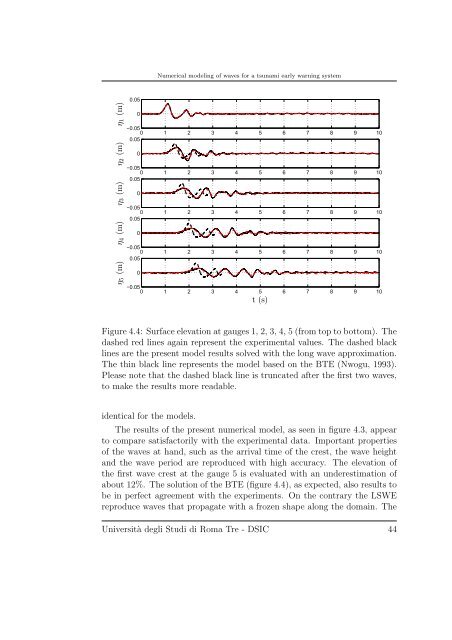Numerical modeling of waves for a tsunami early warning system
Numerical modeling of waves for a tsunami early warning system
Numerical modeling of waves for a tsunami early warning system
You also want an ePaper? Increase the reach of your titles
YUMPU automatically turns print PDFs into web optimized ePapers that Google loves.
η1 (m)<br />
η2 (m)<br />
η3 (m)<br />
η4 (m)<br />
η5 (m)<br />
0.05<br />
0<br />
<strong>Numerical</strong> <strong>modeling</strong> <strong>of</strong> <strong>waves</strong> <strong>for</strong> a <strong>tsunami</strong> <strong>early</strong> <strong>warning</strong> <strong>system</strong><br />
−0.05<br />
0<br />
0.05<br />
1 2 3 4 5 6 7 8 9 10<br />
0<br />
−0.05<br />
0<br />
0.05<br />
1 2 3 4 5 6 7 8 9 10<br />
0<br />
−0.05<br />
0<br />
0.05<br />
1 2 3 4 5 6 7 8 9 10<br />
0<br />
−0.05<br />
0<br />
0.05<br />
1 2 3 4 5 6 7 8 9 10<br />
0<br />
−0.05<br />
0 1 2 3 4 5 6 7 8 9 10<br />
t(s)<br />
Figure 4.4: Surface elevation at gauges 1, 2, 3, 4, 5 (from top to bottom). The<br />
dashed red lines again represent the experimental values. The dashed black<br />
lines are the present model results solved with the long wave approximation.<br />
The thin black line represents the model based on the BTE (Nwogu, 1993).<br />
Please note that the dashed black line is truncated after the first two <strong>waves</strong>,<br />
to make the results more readable.<br />
identical <strong>for</strong> the models.<br />
The results <strong>of</strong> the present numerical model, as seen in figure 4.3, appear<br />
to compare satisfactorily with the experimental data. Important properties<br />
<strong>of</strong> the <strong>waves</strong> at hand, such as the arrival time <strong>of</strong> the crest, the wave height<br />
and the wave period are reproduced with high accuracy. The elevation <strong>of</strong><br />
the first wave crest at the gauge 5 is evaluated with an underestimation <strong>of</strong><br />
about 12%. The solution <strong>of</strong> the BTE (figure 4.4), as expected, also results to<br />
be in perfect agreement with the experiments. On the contrary the LSWE<br />
reproduce <strong>waves</strong> that propagate with a frozen shape along the domain. The<br />
Università degli Studi di Roma Tre - DSIC 44

















